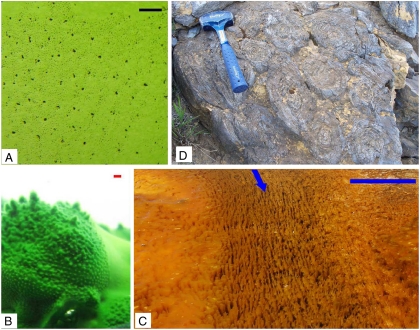Fig. 4.
When cone-forming bacteria grow in still water, they grow into a roughly hexagonal arrangement. Laboratory cultures grow into such an organization on both the smooth surface of a glass beaker (A) or on the surface of a growing mat (B); both scale bars are 1 mm. When stromatolites grow in moving water, competition is mediated by advection as well as diffusion. (C) In a unidirectional flow, long ridges grow with a centimeter-scale spacing between ridges. The blue arrow indicates the direction of flow. On either side of the channel the mat is too thick to permit flow. The scale bar is 30 cm. (D) The regular spacing and roughly hexagonal arrangement of 1.4 Gya conical stromatolites from the Bakal formation (31, 32) may be due to competition for nutrients mediated by eddy diffusivity. The hammer is 27.9 cm long.

